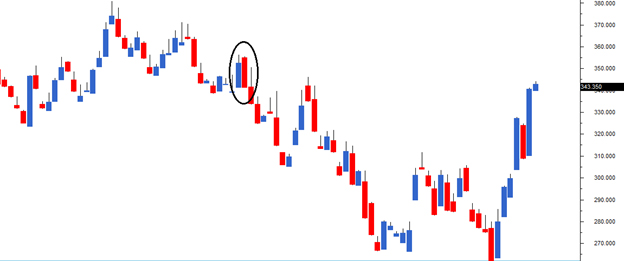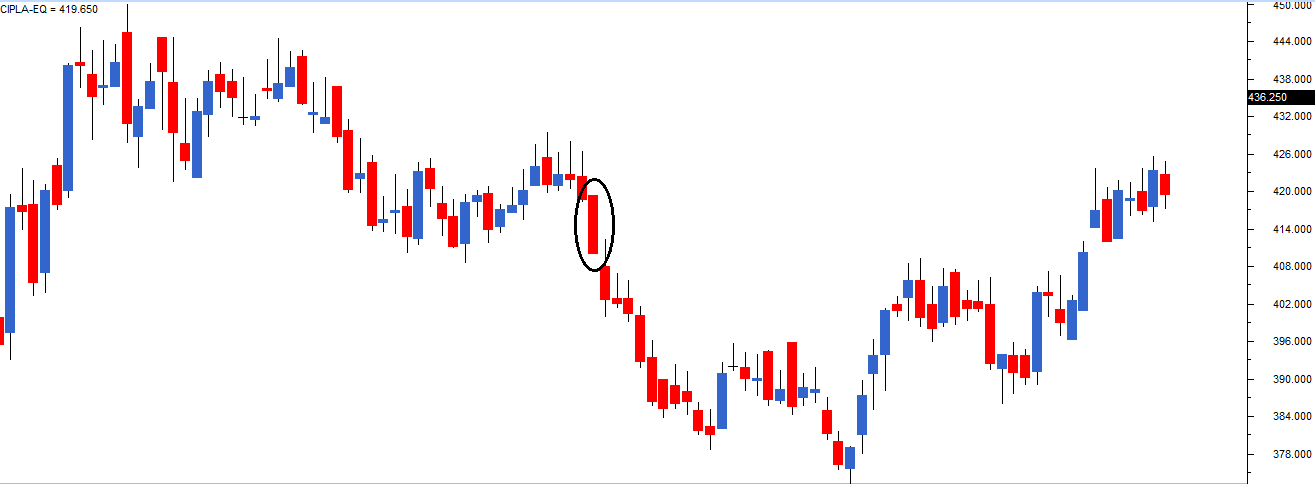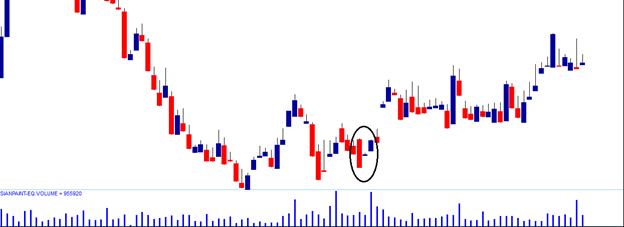Bearish Marubozu indicates extreme bearishness. Here the open is equal to the high and close the is equal to low. Open = High, and Close = Low.
A bearish marubozu indicates that there is so much selling pressure in the stock that the market participants actually sold at every price point during the day, so much so that the stock closed near its low point of the day. It does not matter what the prior trend has been, the action on the marubozu day suggests that the sentiment has changed and the stock is now bearish.
The expectation is that this sudden change in sentiment will be carried forward over the next few trading sessions and hence one should look at shorting opportunities. The sell price should be around the closing price of the marubozu.

In the chart above (BPCL Limited), the encircled candle indicates the presence of a bearish marubozu. Notice the candle does not have an upper and a lower shadow. The OHLC data for the candle is as follows:
Open = 355.4, High = 356.0, Low = 341, Close = 341.7
As we had discussed earlier a minor variation between the OHLC figures leading to small upper and lower shadows is ok as long as it is within a reasonable limit.
The trade on the bearish marubozu would be to short BPCL approximately at 341.7 with a stoploss at the high point of the candle. In this case the stoploss price is 356.0. Of course at this stage we still haven’t dealt with setting targets, and we will figure that out much later in this module.
Do remember this, once a trade is initiated you should hold on to it until either the target is hit or the stoploss is breached. If you attempt to do something else before any one of these event triggers, then most likely your trade could go bust. So staying on course of the plan is extremely crucial.
Trade can be initiated based on the risk appetite of the person. The risk taker can initiate a short trade on the same day around the closing. Of course, he has to make sure that the candle is forming a bearish marubozu. To do this at 3:20PM the trader has to confirm if the open is approximately equal to the high and the current market price is equal to the low price. If the condition is validated, then it is a bearish marubozu and hence a short position can be initiated.
If the trader is risk averse, he can wait till the next day’s closing. The short trade will go through only by 3:20PM next day after ensuring that the day is a red candle day. This is also to ensure that we comply with 1st rule – Buy strength, and Sell weakness.
In the BPCL chart above, both risk taker and risk averse would have been profitable.
Here is another chart, Cipla Limited, where the bearish marubozu has been profitable for both risk taker, and a risk averse trader. Remember these are short term trades and one needs to be quick in booking profits.

Here is a chart which show bearish marubozu pattern which would have not worked out for the risk taker but a risk averse trader would have entirely avoided initiating the trade, thanks to rule 1.

The trade trap
Earlier in this chapter we did discuss about the length of the candle. One should avoid trading during an extremely small (below 1% range) or long candle (above 10% range).
A small candle indicates subdued trading activity and hence it would be difficult to identify the direction of the trade. On the other hand a long candle indicates extreme activity. The problem with lengthy candles would be the placement of stoploss. The stoploss would be deep and in case the trade goes wrong the penalty to pay would be painful. For this reason, one should avoid trading on candles that are either too short or too long.
Note:-
- Buy around the closing price of a bullish marubozu
- Keep the low of the marubozu as the stoploss
- Sell around the closing price of a bearish marubozu
- Keep the high of the marubozu as the stoploss
- Short candle indicates subdued activity
- Long candle indicates extreme activity, however placing stoploss becomes an issue.



0 Comments